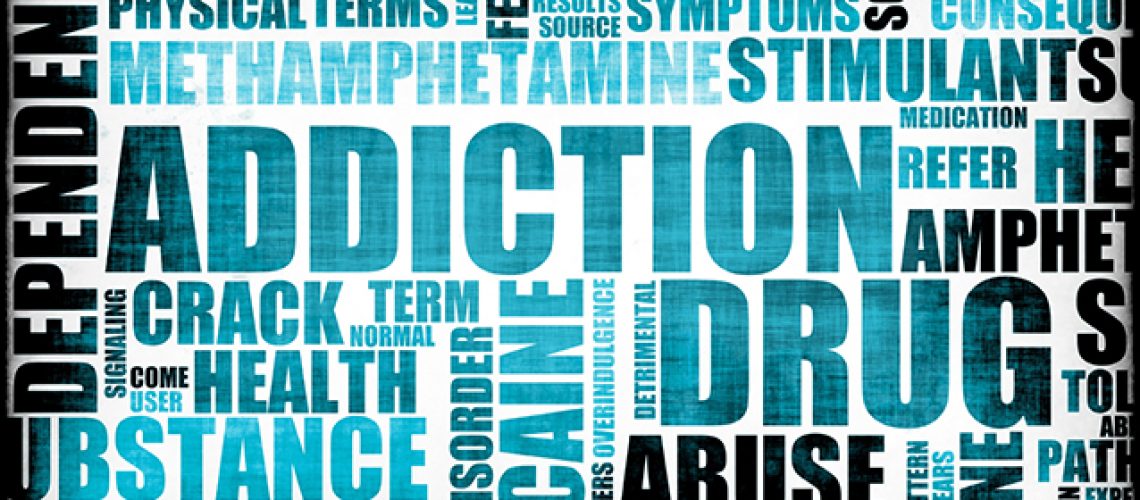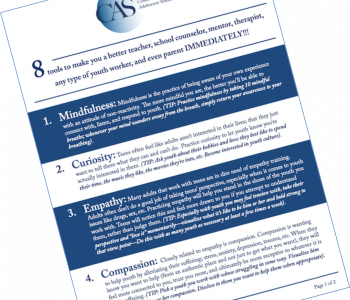

Sam Himelstein, PhD
Sam Himelstein is the founder and CEO of the Center for Adolescent Studies, Inc. He is passionate about working with youth and training the professionals that serve them.
Substance Abuse Treatment Does NOT Happen In A Vacuum
Most of us know that working with teens can be challenging. For those of us conducting drug treatment, we this can be an uphill battle that’s so difficult that we can’t stay attached to outcome, or we’d be constantly disappointed. Oftentimes teens that are chronic drug users have no interest in stopping their use, an inherent barrier that makes substance abuse treatment difficult. The below brief example may seem familiar to some professionals:
A substance abusing teen is in and out of juvenile hall, and each time incarcerated has comes in drunk. He struggles with many drugs, but alcohol appears to be his drug of choice. I was working him recently and he stated: “if I were to get released today, I’d go drink immediately.” Not to mention that this young man was on his way to an out-of-state group home, usually a punishment just short of going to state prison (for youth), but he also had no insight into the fact that he was drunk every time he committed a crime or that drinking/drug use had anything to do with his current predicament.
While I do believe that there are rare cases of individuals who experiment with drugs and become addicts, it only takes a little bit of digging on most drug abusers and/or addicts to find a deeper story. A story that often includes issues such a depression, anxiety, tremendous stress, and in many cases trauma. In multiple studies on adverse childhood experiences (ACEs), researchers found that those with ACEs developed some form of problem drug behavior during adulthood. What this suggests is that substance use can be a symptom of a much larger issue (rather than previously thought as a separate, isolated problem). It wasn’t long ago that the status quo in mental health treatment was the if a client was addicted or struggled with drugs, they needed to go to substance abuse treatment and reduce or stop their drug use prior to engaging in mental health treatment (e.g., working on their depression or trauma). Such a philosophy is antiquated and potentially dangerous. To isolate drug use, as if it were in a vacuum, away from trauma, depression, anxiety, etc. is to invalidate the etiology of the drug use in the first place. This was one of the bases for differentiating substance abuse counselors from other mental health professionals, and still today in some settings you’ll hear that a youth needs go see her “substance abuse counselor” from her therapist’s mouth (This isn’t to say that substance abuse counselors cannot be well trained. Although they often have much less formal education than other mental health professionals, they often make up for it in life experience. I have worked with and supervised many substance abuse counselors that have been excellent at their jobs, but all of them shared in common a willingness to sit with clients and their full stories, not simply the substance abuse aspect). Therefore if we don’t tackle such issues concurrently while dealing with substance abuse, there’s more of a likelihood that the young person will end up relapsing.
Drug use does NOT exist in a vacuum. Substance abuse treatment shouldn’t either. Below are 3 simple philosophical tenants to help you facilitate competent substance abuse treatment while still validating the issues that most substance abusers and/or addicts deal with (especially trauma).
1) Assume That There’s More To It Than Simply Drug Use
We all know we’re not supposed to assume, especially in clinical work. However, it’s safe to say that many young people who are struggling with drugs have other issues going on. These could be anything from wanting to achieve a high grade on a math exam to extreme trauma. If we consider that there’s more to drug use than simply wanting to use drugs to make parents, therapists, and probation officers angry, we are opening the doors to a better understanding of the young people we work with and have a better chance to actually help them. If we isolate substance abuse as it’s own disconnected problem, we run the risk of failing to understand the true nature of the young person’s suffering. And as for assuming the above and being wrong (i.e., in those rare cases where there is no deeper issues and substance use really is the core problem), it’s better to be safe and wrong. Accept the assumption as a mistake and then move on.
2) Don’t Push It
Not pushing it means to not push discussing drugs before the young person/client you’re working with is ready. It’s excruciatingly important to build rapport and create a trusting environment so that the youth feels comfortable speaking with you. Once that happens, discussing substance use and abuse is much more indicated. If a young person doesn’t trust you, or doesn’t feel comfortable with you, you’re probably not going to get much from them in terms of content let alone the fact that they may flat out lie to you. I’ve worked with many youth who are comfortable speaking about substance use and abuse in the first session, and many who weren’t. Use professional judgment (and your gut) about when it feels appropriate to bring up substance use and abuse, and then do so in a non-judgmental way. This of course depends on building authentic relationships with young people, a critical component of substance abuse treatment (or any treatment for that matter).
3) Keep a Relaxed Stance on Behavioral Change (Drug Use)
I’ve written and talked at length about alternative stances on behavior change; that is, to not force change on youth before they’re ready or they will only push back harder. The behavior in question here is drug use and if you try to force a youth to change, they often will not. They will often push back and nurture narratives in their minds that support their drug use. Let alone, if you really sit down and contemplate it, you would probably come to the authentic conclusion that none of us can actually make someone stop using drugs. You can’t supervise them 24/7. Parents, let alone courts can’t even do that. The courts can incarcerate someone, but even then drugs still can be used/abused in correctional settings and/or youth can use them when released. Alternatively, if you create a non-judgmental atmosphere when it comes to drug use, the youth you’re working with will most likely be more open to conversations about using drugs. This is the first (and a very important) step in drug treatment. If youth won’t even talk to you about drugs, it’ll be very difficult having any meaningful conversations about treatment.
The other issue to consider under here is that drugs actually help with some of those deeper issues that the youth are dealing with. And they often work quite well. For example, many youth I work with abuse marijuana to relax. Many of these youth also suffer from extreme forms of complex trauma and have hyper-vigilant central nervous systems (i.e., they can become extremely reactive very fast as a result of their traumas). When they smoke marijuana, it relaxes the central nervous system and can result in the individual feeling a subjective sense of relaxation. And because marijuana can be smoked quickly, it is, at least in some sense, and effective coping method. Thus, in order to help a young person deal with something such as hyper-vigilance, we have the responsibility of teaching them new methods to integrate into their lives to substitute coping mechanisms such as drug use. And this is often a slow dance, one that takes patience and a strong will of both youth and adult.
—
The take away from this brief post is that substance abuse can be a complex, entangled issue that is resultant from deeper stresses, depression, and often trauma. The above philosophical tenants are a start to a trauma-informed perspective on working with substance abusing and dependent youth. Effective substance abuse treatment does NOT happen in a vacuum. It occurs within an intricate framework of related issues, oftentimes traumas, and truly understanding this is a precursor for effective substance abuse treatment.
For more helpful tips on working with substance-impacted youth check out the posts below:
3 Tips for Using Mindfulness in Substance Abuse Treatment with Adolescents
3 Ways Traumatic Events Impact Teen Substance Abuse
Did You Ever Do Drugs? 3 Responses for Adults Working with Adolescents
The Five Major Types of Drugs Used by Teens
For FREE ongoing training and development on working with substance using adolescents and young adults, join out FREE Training Community, which offers monthly LIVE trainings and self-paced courses, all with CE for eligible professionals.

